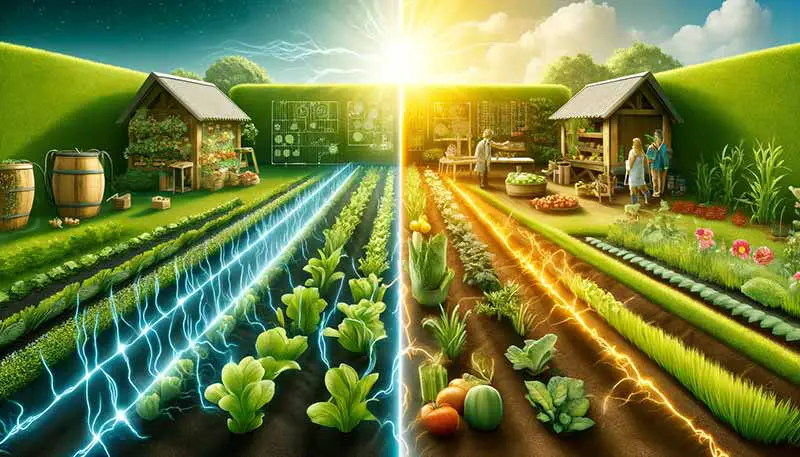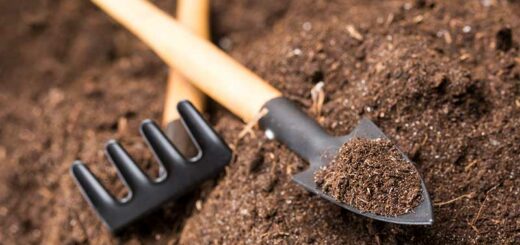Electroculture vs. Traditional Gardening
Gardening, an age-old practice cherished by many, encompasses a variety of methods to cultivate plants, whether for food, aesthetic pleasure, or ecological benefits. Understanding the diverse techniques available can significantly enhance your gardening experience and outcomes.
Two prominent approaches that gardeners often consider are electroculture and traditional gardening. Each method offers distinct advantages and challenges, making exploring their characteristics and applications essential.
Brief Overview of Gardening Methods
Gardening techniques have evolved over centuries, adapting to changing environments, technologies, and cultural practices. Traditional gardening, rooted in historical practices, involves soil preparation, planting, watering, weeding, and harvesting. This approach leverages natural processes and organic materials to foster plant growth.
In contrast, modern innovations like electroculture introduce a scientific twist to gardening. Electroculture utilizes electrical fields to stimulate plant development, offering a unique way to boost crop yields and health. By integrating technology with horticultural practices, electroculture represents a forward-thinking approach to gardening.

Introduction to Electroculture and Traditional Gardening
Electroculture is a novel method incorporating electrical energy to enhance plant growth and productivity. This technique leverages low-level electrical currents to stimulate plant cellular activities, promoting faster and more robust development. The principles of electroculture are grounded in scientific research, aiming to optimize plant health and output without relying heavily on chemical fertilizers.
On the other hand, traditional gardening embodies the wisdom passed down through generations. This method involves tried-and-true practices such as composting, crop rotation, mulching, and companion planting. Traditional gardening emphasizes harmony with nature, using organic inputs and sustainable techniques to nurture plants.
Importance of Understanding Different Gardening Techniques
In today’s world, where sustainable living and food security are increasingly vital, understanding various gardening techniques can make a significant difference. By learning about electroculture and traditional gardening, you can make informed decisions aligning with your gardening goals and environmental values.
Electroculture offers potential benefits like increased yields and reduced chemical usage, appealing to those seeking innovative, eco-friendly solutions. Meanwhile, traditional gardening provides a reliable and accessible way to grow plants, fostering a deep connection to nature and promoting biodiversity.
Benefits of Electroculture
Enhanced Plant Growth and Productivity
One of the most notable advantages of electroculture is its ability to boost plant growth and productivity significantly. By applying low-level electrical currents to the soil and plants, electroculture stimulates cellular activity and nutrient uptake.
This enhanced physiological response leads to faster and more vigorous growth, resulting in higher yields. Gardeners utilizing electroculture often observe larger, healthier plants and increased fruit or vegetable production compared to traditional methods.
Decreased Dependence on Chemical Inputs
Electroculture can substantially reduce the reliance on chemical fertilizers and pesticides. The electrical stimulation helps plants absorb nutrients more efficiently, decreasing the need for synthetic fertilizers.
Additionally, the improved health and resilience of plants grown with electroculture make them less susceptible to pests and diseases, reducing the necessity for chemical pest control measures. Reducing chemical inputs lowers gardener costs and minimizes the potential for chemical runoff and environmental contamination.
Environmental Advantages
Electroculture has significant environmental benefits. It helps decrease gardening’s environmental footprint by diminishing the need for chemical fertilizers and pesticides. Reducing chemical usage leads to less pollution of soil and water sources, promoting a healthier ecosystem.
Moreover, electroculture can enhance soil health by stimulating beneficial microbial activity, further contributing to sustainable gardening practices. As a result, this innovative technique aligns well with eco-friendly and sustainable agriculture principles, supporting biodiversity and reducing the environmental impact.
Comparing Electroculture and Traditional Gardening
When evaluating electroculture and traditional gardening, it is essential to understand the key distinctions between these methods. Each approach offers unique techniques and outcomes, entails different costs and resource requirements, and is suitable for various plants and climates.
Differences in Techniques and Outcomes
Electroculture and traditional gardening employ fundamentally different techniques to nurture plant growth. Electroculture uses electrical fields to stimulate plants, enhancing nutrient uptake, cellular activity, and overall vitality.
This modern approach often leads to accelerated growth rates, larger yields, and healthier plants. Applying electrical energy can also improve soil health by fostering beneficial microbial activity.
In contrast, traditional gardening relies on time-honored practices such as soil preparation, organic composting, crop rotation, and manual pest control. These methods emphasize working in harmony with natural processes, using organic materials and techniques to cultivate plants.
Due to centuries of refined practices, traditional gardening outcomes are typically more predictable and consistent. Gardeners who prefer a hands-on, nature-centered approach often favor traditional methods for their reliability and simplicity.
Costs and Resource Requirements
The financial and resource investments required for electroculture and traditional gardening can differ significantly. Electroculture may involve higher initial costs due to the need for specialized equipment, such as electrical generators, electrodes, and monitoring devices.
Additionally, ongoing energy consumption and electrical system maintenance expenses may occur. However, the potential for increased yields and reduced chemical input costs can offset these initial investments over time.
Traditional gardening, on the other hand, generally requires lower upfront expenditures. Basic tools like shovels, hoes, watering cans, and organic materials such as compost and mulch are relatively inexpensive and widely available. The primary investment in traditional gardening is often time and labor, as these methods can be more physically demanding and require regular upkeep.
Nevertheless, traditional gardening can be cost-effective in the long run, especially when homemade compost and natural pest control methods are utilized.
Suitability for Different Types of Plants and Climates
The suitability of electroculture and traditional gardening varies based on the types of plants being cultivated and the specific climate conditions.
Electroculture can be particularly effective for high-yield crops, fast-growing vegetables, and plants that benefit from enhanced nutrient absorption. This method can also be advantageous in controlled environments such as greenhouses, where conditions can be optimized for electrical stimulation.
Traditional gardening is highly versatile and adaptable to various plants and climates. It is well-suited for perennial plants, native species, and crops that thrive under organic cultivation. Traditional techniques can be easily adjusted to local environmental conditions, making them ideal for gardeners in diverse regions with varying soil types and weather patterns.
In conclusion, electroculture and traditional gardening offer valuable benefits but differ in their techniques, costs, and suitability.
Electroculture’s innovative approach can lead to remarkable growth and yield improvements, while traditional gardening provides a reliable and sustainable method grounded in natural principles. Understanding these differences can help gardeners choose the best approach for their needs and circumstances, ensuring a productive and rewarding gardening experience.
Challenges and Considerations
When deciding between electroculture and traditional gardening, weighing each method’s potential drawbacks and limitations is important. Both approaches have unique challenges, and understanding these can help you make an informed decision that best suits your gardening goals and conditions.
Potential Drawbacks of Electroculture
While electroculture offers numerous benefits, it also comes with certain challenges. One of the primary drawbacks is the initial cost. Setting up an electroculture system can be expensive due to the need for specialized equipment such as electrodes, electrical generators, and monitoring devices. Additionally, there can be ongoing costs related to energy consumption and maintenance.
Another consideration is the technical knowledge required to effectively implement and manage electroculture systems. Gardeners must understand how to apply electrical currents safely and optimize them for different plant species. Without proper knowledge, plants may be damaged, or the desired results may not be achieved.
Furthermore, electroculture may not be suitable for all plant types or growing conditions. Some plants may not respond well to electrical stimulation, and certain environments might challenge the effective deployment of electroculture techniques. For instance, areas with frequent electrical storms or high moisture levels might complicate the use of electroculture systems.
Limitations of Traditional Gardening
Traditional gardening, while reliable and widely practiced, also has its limitations. One of the main challenges is its labor-intensive nature. Traditional gardening requires significant physical effort for soil preparation, planting, weeding, and pest control. This can be demanding, especially for larger gardens or individuals with limited mobility.
Another limitation is the dependency on natural factors such as weather conditions, soil quality, and water availability. Traditional gardening techniques are highly susceptible to variations in these factors, affecting plant growth and yield. Adverse weather conditions, poor soil health, or inadequate water supply can hinder the success of traditional gardening efforts.
Additionally, traditional gardening methods can sometimes be less efficient regarding resource use and productivity than modern techniques like electroculture. The reliance on organic inputs and manual processes can limit traditional gardens’ scalability and yield potential, making it challenging to achieve high productivity quickly.
Factors to Consider When Choosing Between the Two Methods
When choosing between electroculture and traditional gardening, several factors should be considered to determine the most suitable approach for your needs:
- Goals and Objectives: Consider what you aim to achieve with your gardening efforts. If you seek high yields and rapid growth, electroculture might be more appropriate. Traditional gardening may be preferable if you value sustainability, tradition, and a hands-on approach.
- Budget and Resources: Assess your budget and the resources available to you. Electroculture requires an initial investment in equipment and ongoing energy costs, whereas traditional gardening may require more time and physical labor but less financial outlay.
- Technical Expertise: Evaluate your level of technical knowledge and willingness to learn. Electroculture necessitates understanding and managing electrical systems, while traditional gardening relies more on practical gardening skills and knowledge of organic practices.
- Environmental Conditions: Consider the climate and soil conditions of your gardening area. Some environments may better suit traditional methods, while others might benefit more from electroculture’s technological advantages.
- Plant Types: Think about the types of plants you want to grow. Some plants may thrive under electroculture, while others are better suited to traditional methods. Research the specific needs of your chosen plants to determine the best approach.
Conclusion
Gardening offers many methods to cultivate healthy and productive plants, with electroculture and traditional gardening as prominent approaches. Electroculture leverages electrical fields to stimulate plant growth, increase yields, reduce the need for chemical inputs, and provide potential environmental benefits.
In contrast, traditional gardening relies on time-tested techniques emphasizing natural processes, sustainability, and a hands-on connection to nature. Each method has unique advantages, challenges, and applications, making understanding their differences and potential outcomes essential.
Personal Recommendation Based on Specific Gardening Goals
When deciding between electroculture and traditional gardening, aligning your choice with your specific gardening objectives is crucial. If your primary goal is to maximize plant growth and productivity with the aid of modern technology, electroculture could be a suitable option. Its ability to enhance nutrient absorption and boost yields can benefit high-demand crops and controlled environments like greenhouses.
On the other hand, if you value a more holistic, organic approach that fosters a deeper connection to the natural world, traditional gardening may be the way to go. This method allows for flexibility and adaptability to various environmental conditions and is ideal for those who enjoy nurturing plants naturally.
Encouragement to Experiment and Find the Best Method for Individual Needs
Ultimately, the best gardening method for you will depend on your personal preferences, resources, and environmental factors. Experimenting with electroculture and traditional gardening is highly beneficial in determining which approach aligns best with your needs and goals. Trying out different techniques can provide valuable insights and help you discover the most effective ways to cultivate your garden.
Gardening is a journey of learning and adaptation. Whether you harness the power of electroculture or embrace the traditions of organic gardening, the key is to remain open to experimentation and continuous improvement. You can create a thriving garden that reflects your unique vision and circumstances by exploring and combining different methods.
Reference Sources:
- Books:
- “Electroculture: Theory and Practice of Application of Electricity to Horticulture” by Justin Christofleau.
- “The Organic Gardener’s Handbook of Natural Pest and Disease Control” by Fern Marshall Bradley, Barbara W. Ellis, and Deborah L. Martin.
- “The Garden Primer” by Barbara Damrosch.
2. Academic Journals and Papers:
- “Electroculture: A review of the evidence” by Michael W. Ford et al., published in Agricultural Research Journal.
- “The Effect of Electric Fields on Plant Growth and Development” by S. B. Parodi, published in the Journal of Experimental Botany.
- “Traditional and Modern Gardening Techniques: A Comparative Study” by Emily Green, published in Horticulture Science Journal.
3. Websites and Online Resources:
- University of California Agriculture and Natural Resources – Articles on traditional gardening techniques.
- Permaculture Research Institute – Resources on sustainable gardening practices.
- Royal Horticultural Society – Information on various gardening methods and techniques.



